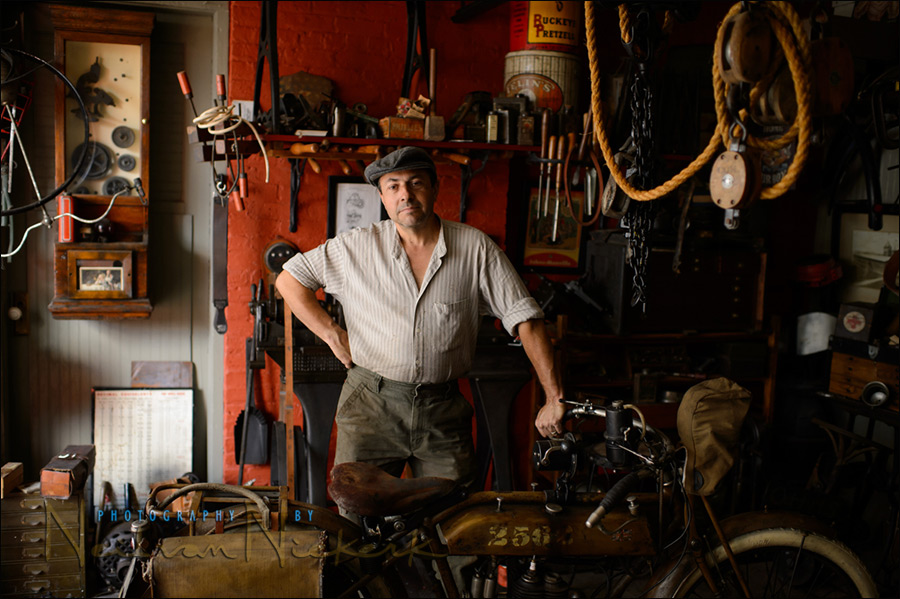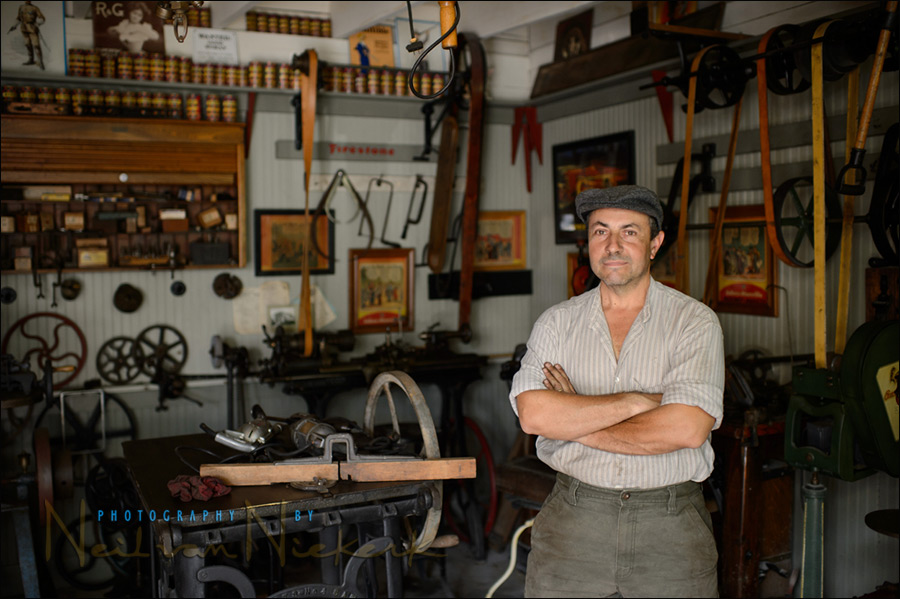
Photography: Using light fall-off to illuminate your subject
John collects vintage … oh, everything. His entire house filled with collectibles – it is like stepping out of a time-machine into a different era. I joked with him that the only two things in his house from the 21st century is his fridge and his dog! Most impressive in a way, is John’s workshop where he maintains his two vintage era motorbikes and a Model A Ford. The tools in his workshop are all authentic to the era and are hand tools – no electric tools – and they work. The way John describes it, it actually makes sense in the way he maintains everything with hand-tools and lathes and such.
I wanted to portray him amongst all these items. And I wanted to stay true to the spirit of what was presented, and just use the available light. Sweeping the garage doors open, there was a flood of soft, directional light – perfect.
Shooting at a right angle to the light streaming in, there is that dynamic interplay between light and shade as the light faded off the deeper we look into the workshop.
That gradient of light isn’t linear – it falls off according to the inverse square law from the open garage door. In where we position our subject and therefore adjust our exposure, the exposure ratio between our subject and the background can change. We can control it.

- 1/160 @ f/1.8 @ 800 ISO? … available light
- Nikon D4
- Nikon 35mm f/1.4G
Shooting deeper into the workshop, everything is lit more or less the same, since everything in the frame is nearly equidistant to the light flooding in from the garage door.
Lighting & Design for Portrait Photography
Lighting & Design is a follow-up of sorts to Direction & Quality of Light. It’s a slightly eclectic mix, discussing the thought-process with various scenarios shooting portraits. The examples use available light, bounce flash, off-camera flash as well as studio lighting.
The idea is that in every one of the 60 sections, there is something to be learnt and applied, regardless of your level as a photographer or where you shoot – all shaped to form a cohesive narrative arc throughout the book.
You can either purchase a copy via Amazon USA or Amazon UK. The book will also available on the Apple iBook Store, and Amazon Kindle.
The next two images will illustrate clearly how the light fall-off to the background can change where our attention is focused. These two photos are quite similar, except that with the first one, John is further back into the workshop. Therefore about the same amout of light reaches him as does the tools and workbenches behind him.

- 1/250 @ f/2.0 @ 800 ISO … available light
- Nikon D4 / Nikon 35mm f/1.4G

- 1/250 @ f/2.0 @ 200 ISO … available light
- Nikon D4 / Nikon 35mm f/1.4G
In this photo, he had stepped forward, closer to the and in getting corrrect exposure for him now (more brightly lit by the light coming in from the garage doors), the background is now comparatively much darker. It would need additional lighting to pick that up to proper exposure again. While a light behind him as back-lighting would’ve helped separate him from the background, I wanted to keep it to natural lighting.
As an aside, John affected a “Strong Man” pose, which is also reminiscent of a previous era.
There is a two-stop drop in exposure if you compare the two images above. (The ISO changed by two stops.) Keeping the exposure correct for John, the background went darker, with just a hint of detail in the back, so the focus is much more on John. In this way, there is a range of positions I could’ve had John stand, (closer or further to the garage door), giving more (or less) light to the background, as I adjust the exposure for him.
Summary
With the inverse-square law in mind, choose specific places to shoot, and specific ways to shoot – always aware of the gradient of light falling on your subject and the scene.
Related articles
- Using interesting available light (model: Olena)
- Available light portraits – Composition, light and style (model: Christy)
- Under- / Over-exposure vs. exposing correctly
- Window-light baby portrait photos
- Other articles on Available Light Photography

It`s also worth to mention how light patterns change. In the first example – Rembrandt light, second example – front light.
Great portraits !
Good reminder that the inverse square law applies to all light, not just strobes.
Hi Neil,
these are the kind of articles that help beginners like me learning how to take photos how to see light.
Thank you for sharing your knowledge.
The inverse square law is something that many people have heard about but don’t really understand the maths behind. Being shown it visually like this really helps those type of learners to ‘get it’
Anther great blog post, thank you.
Baie mooi Neil, The inverse square law is difficult to see with the human eye, but explained like this is excellent, because the light source can’t move, it makes it easier to grasp, and probably test as well. :)